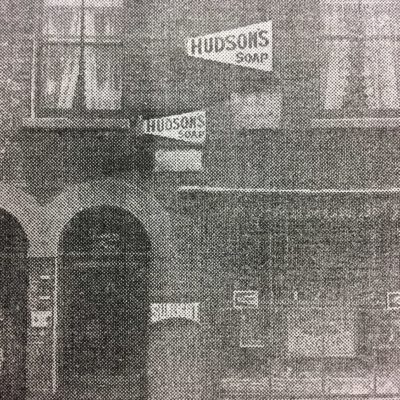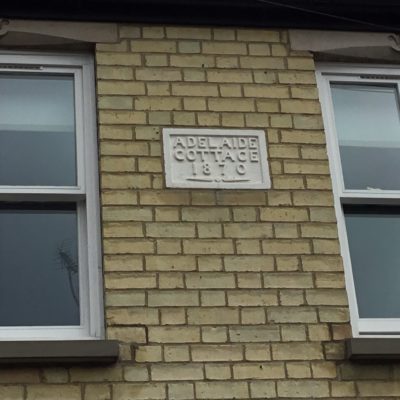Search by topic
- archaeology
- Building of Local Interest
- chapel
- charity
- church
- crime
- dressmaker
- fire
- Great Eastern Railway
- Listed building
- Mapping Relief
- medieval
- oral history
- poverty
- Public House
- Religious House
- Roman
- scholar
- school
- Then and Now
- tudor
- women
- work
- world war one
- world war two
Search by text
27 Ainsworth Street
27 Ainsworth Street
Number 27 is one of a terrace of four houses standing on the west side of Ainsworth Street.
1881 census
John Marsh, head, 46, agricultural labourer (unemployed), b. Ashdon, Essex
Sarah A Marsh, wife, 53, b. Cambridge
Charles Marsh, son, 11, scholar, b. Cambridge
John G Marsh, son, 7, scholar, b. Cambridge
John Marsh was born 29 November 1837 and baptised in Ashdon, Essex. By 1871 John was in Cambridge, lodging with Sarah Bradford and her five children at 15 Crispin Street, near today’s Crispin Place at the back of the Grafton Centre. The youngest child was 1-year-old Charles Bradford, baptised as ‘Charles Marsh Bradford’.
The Electoral Register shows that John Marsh had moved to 27 Ainsworth Street by 1880, and he and his family remained there until 1897. There are earlier records on the Electoral Register of John Marsh living on Ainsworth Street, but the houses were unnumbered in the 1870s. It is possible that the family lived here as early as 1873.
On the 1881 census John is listed as an unemployed agricultural labourer. Charles is 11 and now ‘Charles Marsh’. There is another son, 7-year-old John Griffin, named after his paternal grandfather.
Charles was registered at East Road Boys’ School between August 1881 and July 1882. John was registered at East Road Boys’ School between February 1880 and March 1887.
1891 census
John Marsh, head, 55, general labourer, b. Ashdon, Essex
Sarah Marsh, wife, 63, b. Cambridge
Charles Marsh, son, 21, baker’s assistant, b. Cambridge
John Marsh, son, 17, general labourer, b. Cambridge
Mary A Smith, visitor, 24, assistant in laundry, b. West Molesey, Surrey
The Electoral Register for 1890–1891 shows a Charles Mansfield also living at no. 27. The Marshes were definitely resident until 1897, so perhaps he was a lodger?
By 1901 John and Sarah were living in Garden Cottages, Willow Walk, where John was a grocer’s horsekeeper. Sadly, Sarah was admitted to a lunatic asylum in Essex on 19 October 1901, where she died on 19 March 1909, aged 80. John died in Linton in 1917, aged 82.
1901 census
Robert Darnell, head, 42, railway shunter, b. Trumpington, Cambridgeshire
Rose Darnell, wife, 37, b. Cambridge
Robert William Darnell, son, 15, page boy, b. Cambridge
Dorothy Ida Darnell, daughter, 10, b. Cambridge
Harold I Darnell, son, 7, b. Cambridge
Leonard Alfred Darnell, son, 6, b. Cambridge
Elsie E Darnell, daughter, 3, b. Cambridge
Rose M Darnell, daughter, 2, b. Cambridge
Phillis [Phyllis] Darnell, daughter, 8 months, b. Cambridge
The Electoral Register shows that the Darnell family had moved into no. 27 by 1898.
Robert was from Trumpington, the son of a coprolite digger. He was married to Rose, who had the wonderful maiden name of Pink.
1911 census
Robert Darnell, head, 50, shunter goods, GER, b. Trumpington
Rose Darnell, wife, 47, b. Cambridge
Dorothy Darnell, daughter, 20, dressmaker, b. Cambridge
Harold Darnell, son, 17, grocer’s shop assistant, b. Cambridge
Leonard Darnell, son, 16, errand boy, b. Cambridge
Elsie Darnell, daughter, 14, b. Cambridge
Rose Darnell, daughter, 12, school, b. Cambridge
Phyllis Darnell, daughter, 10, school, b. Cambridge
Eric Darnell, son, 8, b. Cambridge
Robert and Rose had now been married for 28 years and had ten children, of which eight were still living.
The Darnells definitely lived at no. 27 until at least 1916. Robert appears on the 1913 and 1914 Electoral Registers at this property and in 1916 Robert William listed no. 27 as his ‘intended place of residence’ in his Service Record.
Robert died in 1936, aged 76. Rose died in 1945 aged 81.
1921 census
Albert Richard Baker, head, 35, general labourer, H Knights & Sons, b. Cambridge
Florence Eva Baker, wife, 29, home duties, b. Cambridge
Alice Jane Baker, daughter, 9, at school, b. Cambridge
Ernest Lloyd Baker, son, 5, at school, b. Cambridge
Albert Baker worked for H Knights & Sons, Builders and Contractors, Huntingdon Road.
He and his wife Florence had lived at no. 27 from at least 1917, as shown in a news story from that year (Cambridge Independent Press, 7 Sep 1917):
Albert Richard Baker (31), married, of 27 Ainsworth Street, milk carrier and dairyman with Messrs. Arnold and Tupling, dairymen, who put in a claim for exemption [from joining the Army] on the ground of unfitness, now wrote to the Tribunal asking to withdraw his claim. The Tribunal acquiesced.
Albert enlisted in the Royal Flying Corps on 25 September 1917 and into the Royal Air Force on 1 April 1918. His Service Record tells us that he was 5ft7 and had two anchors tattooed on his left forearm. He was discharged in April 1920.
Albert and Florence Baker lived at no. 27 until 1926.
The new residents from 1926 were Thomas and Florence Tingey, who moved here from 2 Ainsworth Street. They had previously lived at 7 Ainsworth Street.
In 1939 Thomas Tingey was working as a stableman for the Cooperative.
Sources: UK census records (1881 to 1921), Cambridgeshire Burgess Rolls, 1939 Register, Register for 1914-1915 Polling District No.8 Petersfield Ward, Essex Baptisms, National School Admission Registers & Log-Books 1870-1914, England & Wales, Civil Registration Birth Index, 1837-1915, UK, Lunacy Patients Admission Registers, 1846-1912, British Army World War I Pension Records 1914-1920, Cambridgeshire, England, Electoral Registers, Burgess Rolls and Poll Books, 1722-1966, Cambridge Independent Press 07 September 1917, British Royal Air Force, Airmen’s Service Records 1912-1939
Contribute
Do you have any information about the people or places in this article? If so, then please let us know using the Contact page or by emailing capturingcambridge@
License
This work is licensed under CC BY-NC-SA 4.0







